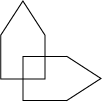Folstein or Mini-Mental Test
The Folstein test, more commonly known as the Mini-Mental test, is used to screen and monitor for signs of senile dementia which includes Alzheimer's disease, among others. The test consists of five parts, each of which assesses various faculties:
- attention and arithmetic;
- spatial and temporal orientation;
- memory;
- language;
- learning abilities.
This 10-minute test is occasionally administered in the doctor's office. You can also take it at home and bring the results to your physician.
Instructions
The test cannot be completed alone. Someone must ask the questions, note the answers and calculate the final score.
| Spatiotemporal orientation | |
|---|---|
| Each correct answer is worth 1 point.
| /10 |
| Registration | |
| Clearly and slowly name 3 random objects (ex.: cigar, flower, door). After having named each of the 3 objects, ask the person to whom you are administering the test to repeat the objects. The score for this section is based on the first set of answers. (1 point for each word that is correctly repeated). Continue repeating the words and have the subject repeat them until they have learnt the words (for the memory portion of the test). If the three words are not correctly repeated after six attempts, discontinue the exercise. If such is the case, the memory portion of the test cannot be completed. | /3 |
| Attention and calculation | |
| Ask the person taking the test to count backwards, starting at 100, while subtracting 7 from every answer. Stop after 5 answers. For those who have difficulty with numbers, you can ask them to count by 2s or 5s. Note the number of correct answers. | /5 |
| If the individual in question refuses or is incapable of completing this exercise, ask them to spell the word "world" backwards. 1 point for each correct letter. *** This alternative score should not be included in the final tally. | ( /5) |
| Recall | |
| Ask the person to repeat the words that you made him learn earlier. One point for every correct answer. | /3 |
| Langage | |
|---|---|
| Naming Show the person a watch and ask them to name the object. Repeat the same exercise with a pen. Both questions must be answered correctly to obtain 2 points (2-0). | /2 |
| Repetition Ask the person to repeat the following sentence after you (only allow one try): "No ifs, ands, or buts" | /1 |
| Three stage command Ask the person to carry out a three-stage command: "Take a piece of paper, fold it in two and throw it on the floor." If the person does not react, give them a piece of paper and repeat the request (1 point per correct gesture). | /3 |
| Written order Ask the person to read and obey a written command that states (1 point or 0): "Close your eyes" | /1 |
| Spontaneous writing Ask the person to write a sentence WITHOUT PROVIDING ANY EXAMPLE. (1 point for a simple sentence, spelling and grammar can be ignored.) | /1 |
| Copying a diagram On a piece of paper, draw two interlocking pentagons (see below) with each side measuring approximately 1 inch. Ask the person to replicate the diagram exactly as is. For 1 point, all ten angles must be drawn and two must intersect. Rotations and tremors can be ignored.  | /1 |
| Total: | /30 |
A healthy adult will score around 30. A lower score, however, should not be cause for concern! The time of day and the person's state of mind at the time of the test can also have an impact on results. If the score is less than 24, the test should be taken over, at another time, to validate the results. It may be advisable to eventually consult your physician.
[UNIPRIX] © Copyright Vigilance Santé
The patient information leaflets are provided by Vigilance Santé Inc. This content is for information purposes only and does not in any manner whatsoever replace the opinion or advice of your health care professional. Always consult a health care professional before making a decision about your medication or treatment.
